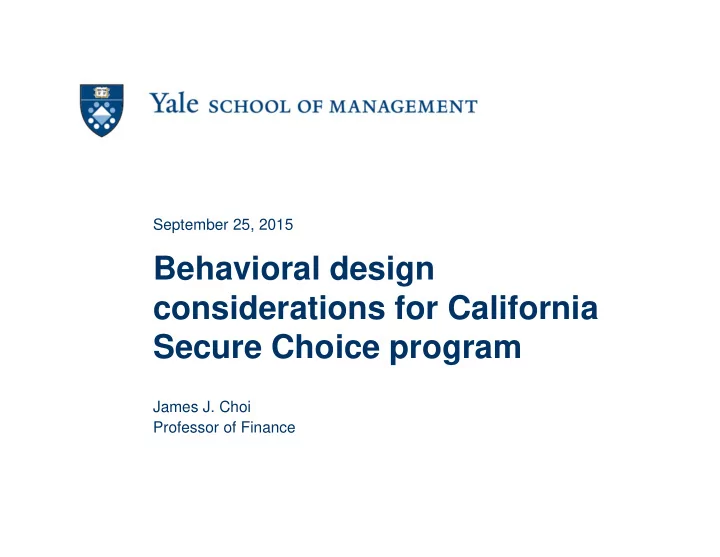

September 25, 2015 Behavioral design considerations for California Secure Choice program James J. Choi Professor of Finance
Outline • Defaults • Active choice enrollment • Simplifying choice sets
Defaults are powerful Source: Beshears, Choi, Laibson, and Madrian, 2008. “The Importance of Default Options for Retirement Savings Outcomes: Evidence from the United States.”
Defaults are not forever, but they are sticky Source: Clark, Utkus, and Young, 2015. “Automatic enrollment: The power of the default” Vanguard Research. Note: Data from 55 401(k) plans shown in graph
High savings defaults do not cause high drop-outs Fraction of employees who stop contributing 30% 25% 20% 15% 10% 5% 0% 2% 3% 4% 5% 6% Initial default contribution rate All Income <$30K Age 25 ‐ 34 Source: Clark, Utkus, and Young, 2015. “Automatic enrollment: The power of the default” Vanguard Research. Note: Employees hired between 1/1/10 and 12/31/12, as of 6/30/13. 139,867 employees in total sample.
Defaults can be dynamic Examples • Automatically raise contribution rate by 1% of income each year unless you opt out • If you’ve stopped contributing, automatically re ‐ enroll you every January unless you opt out
Dynamic defaults are sticky too Source: Clark, Utkus, and Young, 2015. “Automatic enrollment: The power of the default” Vanguard Research. Note: Data from 204 401(k) plans shown in graph
Automatic enrollment is popular In national sample, fraction agreeing with, “You are glad your company offers automatic enrollment” • 98% of those who were automatically enrolled and didn’t opt out • 79% of those who opted out of automatic enrollment Harris Interactive, 2007. “Retirement Made Simpler.” http://www.retirementmadesimpler.org/Library/FINAL%20RMS%20Topline%20Report%2011 ‐ 5 ‐ 07.pdf
Active choice enrollment • Require employees to actively indicate “yes” or “no” to savings plan participation by deadline • Deadline must be enforced
Active choice effect Source: Carroll, Choi, Laibson, Madrian, and Metrick, 2009. “Optimal defaults and active decisions.” Standard enrollment refers to a non ‐ enrollment default.
Simplifying choice set • One disadvantage of active choice is it places full choice burden on employee • Highlighting certain options can make choice easier
Examples of simplifying • Sign this form, and you will be enrolled contributing 5% of your income. Or write in a different percentage here: ____% • Sign this form and pick a contribution rate – 3% of income – 5% of income – 7% of income – Another percentage: ____%
Recommend
More recommend